 Spring is only days away and thoughts turn to new growth and looking for the green signs of the new season. This week’s column from the International Reading Association's Children’s Literature and Reading Special Interest Group presents books on the environment and “green” issues in children’s and YA books. Many of these titles will provide ideas for Earth Day next month on April 22 or for literature-related STEM activities. From looking at animal conservation to recycling and trash, this list of books will help classrooms and libraries build an awareness of our earth and how to preserve it.
Spring is only days away and thoughts turn to new growth and looking for the green signs of the new season. This week’s column from the International Reading Association's Children’s Literature and Reading Special Interest Group presents books on the environment and “green” issues in children’s and YA books. Many of these titles will provide ideas for Earth Day next month on April 22 or for literature-related STEM activities. From looking at animal conservation to recycling and trash, this list of books will help classrooms and libraries build an awareness of our earth and how to preserve it.
Check out ReadWriteThink for the lesson idea "Persuasive Essays: Environmental Issues" (Grades 6-8) or a K-3 lesson called “Protecting Our Precious Planet: Sharing the Message of Earth Day.”
From IRA’s Engage blog, read Jill Robinson’s animal welfare story about “Jasper’s Story.” Another resource from Engage is Jennifer Altieri’s article on “Where’s the L in STEM?”
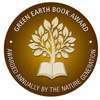 2013 Green Earth Book Award Winners
2013 Green Earth Book Award Winners
- Picture Book: The Family Tree, written and illustrated by David McPhail, published by Henry Holt and Co.
- Children’s Fiction: One White Dolphin, by Gill Lewis, published by Simon & Schuster/Atheneum Books for Young Readers
- Children’s Nonfiction: Citizen Scientists: Be a Part of Scientific Discovery from Your Own Backyard, by Loree Griffin Burns and photographed by Ellen Harasimowicz, published by Henry Holt and Co.
- Young Adult Fiction: Endangered, by Eliot Schrefer, published by Scholastic
- Young Adult Nonfiction: Moonbird: A Year on the Wind with the Great Survivor B95, by Phillip Hoose, published by Farrar, Straus and Giroux
GRADES K-3
Bently, Peter. (2013). National Geographic Wild tales: Look out, cub! A lift-the-flap story about lions. Washington, DC: National Geographic.
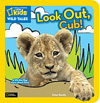 Like most youngsters, this adorable but determined lion cub persists in getting what he wants—some attention. All the curious cub wants is someone to play with, and he won’t stop until someone does exactly that. He tugs, pulls, and flops around, but no one seems to have time for him. When all his efforts are for naught, he entertains himself, and ends up getting in trouble. Young readers will love turning the pages to see what mischief this cub will cause next, and they'll also lifting and pulling the book’s flaps to reveal more about his adventures. It’s safe to say that he’s had more than a lion’s share of them.
Like most youngsters, this adorable but determined lion cub persists in getting what he wants—some attention. All the curious cub wants is someone to play with, and he won’t stop until someone does exactly that. He tugs, pulls, and flops around, but no one seems to have time for him. When all his efforts are for naught, he entertains himself, and ends up getting in trouble. Young readers will love turning the pages to see what mischief this cub will cause next, and they'll also lifting and pulling the book’s flaps to reveal more about his adventures. It’s safe to say that he’s had more than a lion’s share of them.
- Barbara A. Ward, Washington State University Pullman
Cella, Clara. (2013). Earth Day. Mankato, MN: Capstone Press.
 Written for our earliest readers, this celebration of Earth Day explains the concept of taking care of the earth. Using full page photographs opposite the page of text, the history of Earth Day is explained with simple facts highlighting people like Denis Hayes and Gaylord Nelson who worked to establish this special day of awareness for the earth. The concluding pages offer actual suggestions for youngsters as to what they can do every day to help conserve and become more involved in environmental awareness. Suggestions to start a recycling program at home are offered at the end of the book. (p.22)
Written for our earliest readers, this celebration of Earth Day explains the concept of taking care of the earth. Using full page photographs opposite the page of text, the history of Earth Day is explained with simple facts highlighting people like Denis Hayes and Gaylord Nelson who worked to establish this special day of awareness for the earth. The concluding pages offer actual suggestions for youngsters as to what they can do every day to help conserve and become more involved in environmental awareness. Suggestions to start a recycling program at home are offered at the end of the book. (p.22)
- Karen Hildebrand, Ohio Library and Reading Consultant
Dudley, Rebecca. (2013). Hank finds an egg. White Plains, NY: Peter Pauper Press.
 Debut author/illustrator Rebecca Dudley has created an unusual but beautiful wordless picture book about a true act of kindness. Dudley has created collage scenes with ferns, cutout leaves and branches to give the feeling of a forest floor. She has photographed these collages after she placed the main character, a small bear-like forest creature in the center. As Hank is walking through the forest he finds an egg on the forest floor. Looking up, he realizes it has fallen from the nest above. Hank makes several attempts trying to return the egg, first rolling a tree stump under the tree and then building a ladder of twigs, but he just can’t get high enough to return the egg. As the sun sets, Hank is still pondering how to return the egg. He builds a small fire and then crawls into his bed made of leaves, taking the egg with him to keep it warm through the night. The next morning he returns to the nest with a new idea. The mother hummingbird is watching as Hank rolls the egg in moss and carefully ties it with grass and places it on the mother’s beak. She returns it to the nest and the next panel shows the eggs beginning to crack and then hatch. In a very short time, three baby hummingbirds take flight as Hank watches them with great satisfaction on a job well done.
Debut author/illustrator Rebecca Dudley has created an unusual but beautiful wordless picture book about a true act of kindness. Dudley has created collage scenes with ferns, cutout leaves and branches to give the feeling of a forest floor. She has photographed these collages after she placed the main character, a small bear-like forest creature in the center. As Hank is walking through the forest he finds an egg on the forest floor. Looking up, he realizes it has fallen from the nest above. Hank makes several attempts trying to return the egg, first rolling a tree stump under the tree and then building a ladder of twigs, but he just can’t get high enough to return the egg. As the sun sets, Hank is still pondering how to return the egg. He builds a small fire and then crawls into his bed made of leaves, taking the egg with him to keep it warm through the night. The next morning he returns to the nest with a new idea. The mother hummingbird is watching as Hank rolls the egg in moss and carefully ties it with grass and places it on the mother’s beak. She returns it to the nest and the next panel shows the eggs beginning to crack and then hatch. In a very short time, three baby hummingbirds take flight as Hank watches them with great satisfaction on a job well done.
- Karen Hildebrand, Ohio Library and Reading Consultant
Hoena, Blake A. (2013). If an egg hatches … and other animal predictions. Mankato, MN: Capstone Press.
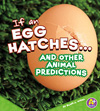 Teachers looking for books with ways to introduce the concept of predicting what lies ahead in a story will find this a useful mentor text to think about that reading concept. Starting with the question, “When an egg hatches, what kind of animal might you find?” (p.3), the following page answers the question with several kinds of animal answers including birds, chicks, reptiles like snakes, turtles, insects, and amphibians. This question pattern continues through the book to predict the color of a desert chameleon, what a dolphin does when it needs air, what geese do when their Canadian rivers and lakes freeze over, what kind of feet otters have, how a mouse keeps its teeth trimmed, how a jellyfish moves, what happens when snow turns the tundra white, and more questions and predictions about animals. The question and answer format will make this an enjoyable read aloud.
Teachers looking for books with ways to introduce the concept of predicting what lies ahead in a story will find this a useful mentor text to think about that reading concept. Starting with the question, “When an egg hatches, what kind of animal might you find?” (p.3), the following page answers the question with several kinds of animal answers including birds, chicks, reptiles like snakes, turtles, insects, and amphibians. This question pattern continues through the book to predict the color of a desert chameleon, what a dolphin does when it needs air, what geese do when their Canadian rivers and lakes freeze over, what kind of feet otters have, how a mouse keeps its teeth trimmed, how a jellyfish moves, what happens when snow turns the tundra white, and more questions and predictions about animals. The question and answer format will make this an enjoyable read aloud.
- Karen Hildebrand, Ohio Library and Reading Consultant
Katz, Susan. (2012). My Mama Earth. Illus. by Melissa Launay. Cambridge, MA: Barefoot Books.
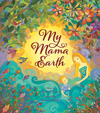 In rhymed couplets against gouache double-page background illustrations, the author has created a journey for a small child to view the earth in a visually artistic way. This poetic writing uses both Mother Nature and the young child’s mother to present the world, the earth, in an endearing style. The story opens as “My mama wakes the eastern sun/ And weaves her magic till day’s done.” (p.2) From there the oceans, birds, seeds, animals, trees, and back to the sun setting and the stars coming out take the young child around the world to enjoy the beauty of the world until he/she is safely back in the arms of his own mother.
In rhymed couplets against gouache double-page background illustrations, the author has created a journey for a small child to view the earth in a visually artistic way. This poetic writing uses both Mother Nature and the young child’s mother to present the world, the earth, in an endearing style. The story opens as “My mama wakes the eastern sun/ And weaves her magic till day’s done.” (p.2) From there the oceans, birds, seeds, animals, trees, and back to the sun setting and the stars coming out take the young child around the world to enjoy the beauty of the world until he/she is safely back in the arms of his own mother.
- Karen Hildebrand, Ohio Library and Reading Consultant
Lawler, Janet. (2013). Ocean counting. Illus. by Brian Skerry. Washington, DC: National Geographic Books.
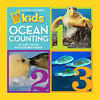 An enticing blend of science and math, this counting book encourages young readers to count the number of creatures visible in each double-page spread. Because the pages are filled with luminous photographs of sea life, readers won’t grow easily bored with it and will enjoy counting the inhabitants of the sea repeatedly. Not only does the title provide counting practice, but it also features engaging descriptive text and interesting facts about the one green sea turtle, the two harp seals, and the nine hammerhead sharks, and other sea life in a "Did You Know?" section at the bottom of the appropriate page. Additionally, after readers have reached the number ten, there is a page containing images of all the animals next to each number, one to ten, and then from ten to one on the facing page, allowing readers to count in reverse order. Back matter also includes brief animal facts about all ten species and a map from which even more counting activities can ensue. This is a worthy addition to any classroom library. Also see Janet Lawler's "Beyond the Notebook: Sparking Ideas for Student Stories" on the Engage blog.
An enticing blend of science and math, this counting book encourages young readers to count the number of creatures visible in each double-page spread. Because the pages are filled with luminous photographs of sea life, readers won’t grow easily bored with it and will enjoy counting the inhabitants of the sea repeatedly. Not only does the title provide counting practice, but it also features engaging descriptive text and interesting facts about the one green sea turtle, the two harp seals, and the nine hammerhead sharks, and other sea life in a "Did You Know?" section at the bottom of the appropriate page. Additionally, after readers have reached the number ten, there is a page containing images of all the animals next to each number, one to ten, and then from ten to one on the facing page, allowing readers to count in reverse order. Back matter also includes brief animal facts about all ten species and a map from which even more counting activities can ensue. This is a worthy addition to any classroom library. Also see Janet Lawler's "Beyond the Notebook: Sparking Ideas for Student Stories" on the Engage blog.
- Barbara A. Ward, Washington State University Pullman
Lepetit, Angie. (2013). Three cheers for trees! A book about our carbon footprint. Mankato, MN: Capstone Press.
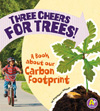 From the Earth Matters series, opening pages of this book show footprints in the sand on a beach providing the analogy to begin a discussion of what a carbon footprint is for young readers. The working definition on page 4 says, “A carbon footprint measures how much you change Earth by using its fossil fuel energy.” It goes on to explain fossil fuels and how humans are using up these energy supplies and they will be gone forever. Beautiful photographs continue the message in this book suggesting ways to conserve and reuse/recycle all kinds of things. Riding a bike instead of using pollution-producing transportation, eating less meat and growing your own vegetables and ending with information about shade and oxygen producing trees are just a few of the suggestions for young citizens. An activity for reusing a glass bottle provided at the end of the book could become a class project. A glossary, suggested reading, Internet sites and an index are included at the end.
From the Earth Matters series, opening pages of this book show footprints in the sand on a beach providing the analogy to begin a discussion of what a carbon footprint is for young readers. The working definition on page 4 says, “A carbon footprint measures how much you change Earth by using its fossil fuel energy.” It goes on to explain fossil fuels and how humans are using up these energy supplies and they will be gone forever. Beautiful photographs continue the message in this book suggesting ways to conserve and reuse/recycle all kinds of things. Riding a bike instead of using pollution-producing transportation, eating less meat and growing your own vegetables and ending with information about shade and oxygen producing trees are just a few of the suggestions for young citizens. An activity for reusing a glass bottle provided at the end of the book could become a class project. A glossary, suggested reading, Internet sites and an index are included at the end.
- Karen Hildebrand, Ohio Library and Reading Consultant
Manushkin, Fran. (2013). Katie saves the earth. Illus. by Tammie Lyon. North Mankato, MN: Picture Window Books.
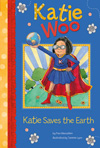 Katie Woo’s teacher, Miss Winkle, asks the class “How can we keep the earth green?” (p.5), as they prepare for Earth Day. As the class brainstorms ideas, both good and bad, about what to do for Earth Day, Katie comments she would like to do something really great. Her idea is to have a yard sale and ask for donations from her classmates and friends to bring items for people to reuse. Katie contributes some of her toys and stuffed animals, JoJo brings a teapot and a broken lamp, and Pedro donates his old jeans and some books he had read. As neighborhood customers and Miss Winkle visit the yard sale, Katie observes how people plan to reuse the items in the yard sale. An appropriate first book for independent young readers to think about how “one man’s junk can be another man’s treasure.”
Katie Woo’s teacher, Miss Winkle, asks the class “How can we keep the earth green?” (p.5), as they prepare for Earth Day. As the class brainstorms ideas, both good and bad, about what to do for Earth Day, Katie comments she would like to do something really great. Her idea is to have a yard sale and ask for donations from her classmates and friends to bring items for people to reuse. Katie contributes some of her toys and stuffed animals, JoJo brings a teapot and a broken lamp, and Pedro donates his old jeans and some books he had read. As neighborhood customers and Miss Winkle visit the yard sale, Katie observes how people plan to reuse the items in the yard sale. An appropriate first book for independent young readers to think about how “one man’s junk can be another man’s treasure.”
- Karen Hildebrand, Ohio Library and Reading Consultant
Middleton, Julie. (2013). Are the dinosaurs dead, Dad? Illus. by Russell Ayto. Atlanta: Peachtree Publishers.
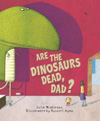 Dave’s father is eager to show off his knowledge about dinosaurs as he and Dave wander through a dinosaur exhibit. While his father points out various features of the dinosaurs on display, Dave keeps seeking reassurance that the prehistoric creatures are, indeed, no longer living. In vividly authentic exchanges between parent and child, Dave repeatedly asks the same questions about the dinosaurs, and his father casually reassures him, paying no mind to his concerns. But as it turns out, like many other parents, Dave's father should have listened to his son. It's never a good idea to ignore a child because sometimes that child has very important information to impart. Readers will enjoy watching what happens to Dad's hat throughout the story and noting the differences between the text and the illustrations, formed with pen and ink, watercolor, pencil crayon, and collage. Teachers might want to pair this one with Toni Buzzeo’s One Cool Friend (Dial, 2012).
Dave’s father is eager to show off his knowledge about dinosaurs as he and Dave wander through a dinosaur exhibit. While his father points out various features of the dinosaurs on display, Dave keeps seeking reassurance that the prehistoric creatures are, indeed, no longer living. In vividly authentic exchanges between parent and child, Dave repeatedly asks the same questions about the dinosaurs, and his father casually reassures him, paying no mind to his concerns. But as it turns out, like many other parents, Dave's father should have listened to his son. It's never a good idea to ignore a child because sometimes that child has very important information to impart. Readers will enjoy watching what happens to Dad's hat throughout the story and noting the differences between the text and the illustrations, formed with pen and ink, watercolor, pencil crayon, and collage. Teachers might want to pair this one with Toni Buzzeo’s One Cool Friend (Dial, 2012).
- Barbara A. Ward, Washington State University Pullman
Oxlade, Chris. (2013). Garbage and recycling. Chicago: Heinemann Library/Capstone Press.
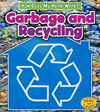 From the series, How Does My Home Work, in simple text and sharp photographs the concepts of what is garbage and what can we do with it is discussed. Garbage is actually defined for young readers in the opening pages and information about the problems that have been created around the world by not disposing of it properly continues the explanation. The design of the book takes a question and answer double-page spread format. Boldface vocabulary words relating to garbage will make word collecting on this theme an easy task. Recycling takes over as the main focus of the latter half of the book with explanations, charts and diagrams and concludes with a task that asks readers “How much garbage does your family recycle in a week?” (p.22) It goes on to ask that readers tally each time they put an object into their recycling bins. Moving beyond just laying out basic facts, this book goes one step further to get readers actively involved in environmental awareness within their own homes.
From the series, How Does My Home Work, in simple text and sharp photographs the concepts of what is garbage and what can we do with it is discussed. Garbage is actually defined for young readers in the opening pages and information about the problems that have been created around the world by not disposing of it properly continues the explanation. The design of the book takes a question and answer double-page spread format. Boldface vocabulary words relating to garbage will make word collecting on this theme an easy task. Recycling takes over as the main focus of the latter half of the book with explanations, charts and diagrams and concludes with a task that asks readers “How much garbage does your family recycle in a week?” (p.22) It goes on to ask that readers tally each time they put an object into their recycling bins. Moving beyond just laying out basic facts, this book goes one step further to get readers actively involved in environmental awareness within their own homes.
- Karen Hildebrand, Ohio Library and Reading Consultant
Porter, Esther. (2013). What’s sprouting in my trash?: A book about composting. Mankato, MN: Capstone Press.
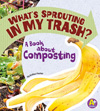 Part of the Earth Matters series, this simple introductory text provides basic information about composting and how it can be a great way to “grow” soil for plants or gardens. Readers learn how to start a compost pile, including what materials to use and what not to include—meat—unless they want to invite animals to forage for food in the compost. The book also contains a simple demonstration that allows readers to create their own small compost pile in a jar, and then use the resulting soil for a plant. This easy-to-do activity offers them a small-scale example of how composting works and might provide support for trying it on a larger scale. The text is complemented with large, colorful photographs. Having explicit directions about how to take a simple action that will keep the Earth green and growing is exactly what young readers need if they are going to change their habits.
Part of the Earth Matters series, this simple introductory text provides basic information about composting and how it can be a great way to “grow” soil for plants or gardens. Readers learn how to start a compost pile, including what materials to use and what not to include—meat—unless they want to invite animals to forage for food in the compost. The book also contains a simple demonstration that allows readers to create their own small compost pile in a jar, and then use the resulting soil for a plant. This easy-to-do activity offers them a small-scale example of how composting works and might provide support for trying it on a larger scale. The text is complemented with large, colorful photographs. Having explicit directions about how to take a simple action that will keep the Earth green and growing is exactly what young readers need if they are going to change their habits.
- Barbara A. Ward, Washington State University Pullman
Stewart, Melissa. (2013). A place for turtles. Illus. by Higgins Bond. Atlanta: Peachtree Publishers.
 The world is filled with wonderful natural delights, some of which rarely cross the minds of humans. The Earth is not intended simply for humans but for small creatures as well. Filled with acrylic illustrations that almost fool readers into thinking they are out on a nature hike, this title lists many reasons to save a spot in our world for turtles. As the engaging, informative text and illustrations highlight different types of turtles, information is provided about the problems caused by the intrusion of humans or the introduction of non-native plants and species to the turtles' habitat. Adding to reader’s enjoyment of this wonderful book is the author's constant insistence about how humans can help the turtles by creating new wetlands, no longer using plastic shopping bags, refusing to collect reptiles, or keeping their dogs on leashes. She even describes several reasons why turtles are an important part of the ecosystem. This is a worthy addition to the other titles in the "A Place for..." series. After exploring this title, readers will certainly want to insure that turtles have safe places to live and grow.
The world is filled with wonderful natural delights, some of which rarely cross the minds of humans. The Earth is not intended simply for humans but for small creatures as well. Filled with acrylic illustrations that almost fool readers into thinking they are out on a nature hike, this title lists many reasons to save a spot in our world for turtles. As the engaging, informative text and illustrations highlight different types of turtles, information is provided about the problems caused by the intrusion of humans or the introduction of non-native plants and species to the turtles' habitat. Adding to reader’s enjoyment of this wonderful book is the author's constant insistence about how humans can help the turtles by creating new wetlands, no longer using plastic shopping bags, refusing to collect reptiles, or keeping their dogs on leashes. She even describes several reasons why turtles are an important part of the ecosystem. This is a worthy addition to the other titles in the "A Place for..." series. After exploring this title, readers will certainly want to insure that turtles have safe places to live and grow.
- Barbara A. Ward, Washington State University Pullman
GRADES 4-6
Burchett, J. and S. Vogler. (2012). Poacher panic. Illus. by Diane Le Feyer. North Mankato, MN: Stone Arch Books/Capstone Publisher.
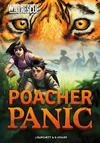 Book #1 in the Wild Rescue series, Ben and Zoe Woodward are not happy when their parents leave for Africa to put their veterinary skills to good use on an adventure without their kids. However, while they are gone, their uncle, Dr. Stephen Fisher, a noted zoologist, convinces Ben and Zoe he needs their help with his secret organization WILD to assist with a problem that deals with endangered animals. Very quickly, they are heading to Sumatra to help Dr. Fisher rescue a tiger and two cubs that are in danger from poachers. Dr. Fisher is sure that by traveling with kids, no one will be the wiser that they are all working together in WILD. Dr. Fisher has some rather ingenious devices and inventions of his own creation to assist with their adventure handling wild animals and unscrupulous villains. Seven more titles in the series allow for more globe-trotting adventures that include other environmental issues involving oceans, earthquakes, avalanches, deserts,
Book #1 in the Wild Rescue series, Ben and Zoe Woodward are not happy when their parents leave for Africa to put their veterinary skills to good use on an adventure without their kids. However, while they are gone, their uncle, Dr. Stephen Fisher, a noted zoologist, convinces Ben and Zoe he needs their help with his secret organization WILD to assist with a problem that deals with endangered animals. Very quickly, they are heading to Sumatra to help Dr. Fisher rescue a tiger and two cubs that are in danger from poachers. Dr. Fisher is sure that by traveling with kids, no one will be the wiser that they are all working together in WILD. Dr. Fisher has some rather ingenious devices and inventions of his own creation to assist with their adventure handling wild animals and unscrupulous villains. Seven more titles in the series allow for more globe-trotting adventures that include other environmental issues involving oceans, earthquakes, avalanches, deserts,
rainforests and safaris.
- Karen Hildebrand, Ohio Library and Reading Consultant
Lewis, Gill. (2012). One white dolphin. Illus. by Raquel Aparicio. New York: Atheneum Books for Young Readers.
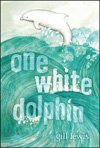 Growing up often means learning to accept unpleasant truths and taking risks. While Kara Wood waits for her long-missing scientist mother to return home, she faces bullying from Jake, son of Dougie Evans, an influential fisherman in her small seaside town. Disappointed in her father, she spends a lot of time running, running in anger, running to escape reality, and running so she doesn't have to face the consequences of her actions. Surprisingly, she and new boy Felix bond over his new love for sailing and their determination to save Angel, a young white dolphin that has been trapped in nets and washed to shore. They also work together to try to save the town's reef. As Kara finds her own voice, she gains the confidence to confront her demons while embracing the good things around her. When Dougie realizes what he has almost lost but has regained, thanks to Kara, he changes his attitude about depleting the area’s abundant resources. Readers are sure to enjoy the eco-friendly theme woven around familiar familial concerns.
Growing up often means learning to accept unpleasant truths and taking risks. While Kara Wood waits for her long-missing scientist mother to return home, she faces bullying from Jake, son of Dougie Evans, an influential fisherman in her small seaside town. Disappointed in her father, she spends a lot of time running, running in anger, running to escape reality, and running so she doesn't have to face the consequences of her actions. Surprisingly, she and new boy Felix bond over his new love for sailing and their determination to save Angel, a young white dolphin that has been trapped in nets and washed to shore. They also work together to try to save the town's reef. As Kara finds her own voice, she gains the confidence to confront her demons while embracing the good things around her. When Dougie realizes what he has almost lost but has regained, thanks to Kara, he changes his attitude about depleting the area’s abundant resources. Readers are sure to enjoy the eco-friendly theme woven around familiar familial concerns.
- Barbara A. Ward, Washington State University Pullman
Parker, Victoria. (2013). Saving the environment. Chicago: Heinemann Library/Capstone Publishers.
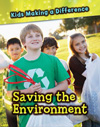 From the Kids Making a Difference series, this book opens posing the question, "Why save the environment?” (p.4) Full of text features like quotations in colorful text boxes, charts, diagrams, bulleted lists, photographs, factoid boxes and informational text, author Victoria Parker has written a comprehensive look at environmental issues around the globe and what people, especially kids, are doing to aid in saving the earth. Felix Finkbeiner and his worldwide efforts to save trees and forests and Bindi Irwin, daughter of Steve Irwin Crocodile Hunter, and her promotion of wildlife efforts are special features. The story of 14-year-old Tom Youngman from Bath, England, and his work with Green Vision are explained. From Indonesia, Adeline Suwana learned about the helpful effects of Mangrove trees for her flooded home region or 10-year-old Alexander Zerphy from Annapolis, Maryland who is trying to protect the young horseshow crabs on the East Coast of the U.S. Other young people and their environmental protection efforts are mentioned in the book which concludes with a map entitled “Making a Difference” (p.42-43) that pinpoints the world-wide locations and work of these kids and ends with ideas that kids everywhere can put into practice to make a better world.
From the Kids Making a Difference series, this book opens posing the question, "Why save the environment?” (p.4) Full of text features like quotations in colorful text boxes, charts, diagrams, bulleted lists, photographs, factoid boxes and informational text, author Victoria Parker has written a comprehensive look at environmental issues around the globe and what people, especially kids, are doing to aid in saving the earth. Felix Finkbeiner and his worldwide efforts to save trees and forests and Bindi Irwin, daughter of Steve Irwin Crocodile Hunter, and her promotion of wildlife efforts are special features. The story of 14-year-old Tom Youngman from Bath, England, and his work with Green Vision are explained. From Indonesia, Adeline Suwana learned about the helpful effects of Mangrove trees for her flooded home region or 10-year-old Alexander Zerphy from Annapolis, Maryland who is trying to protect the young horseshow crabs on the East Coast of the U.S. Other young people and their environmental protection efforts are mentioned in the book which concludes with a map entitled “Making a Difference” (p.42-43) that pinpoints the world-wide locations and work of these kids and ends with ideas that kids everywhere can put into practice to make a better world.
Teachers will appreciate the tips for using the text features given on the Contents page guiding students to look for the special boxed information inserted throughout the book.
- Karen Hildebrand, Ohio Library and Reading Consultant
GRADES 7-12
Senker, Cath. (2013). A teen guide to being eco in your community. Chicago: Heinemann Educational Books.
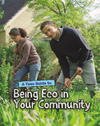 Filled with suggestions about how teenagers can become green-friendly and help the environment, this book is sure to inspire changes in individual actions, possibly motivating those individuals to push for larger systemic changes. The author’s suggestions about how to become an eco-warrior through simple but effective steps are sound and easy to incorporate. For instance, she reminds readers to reuse materials, buy clothing made from recyclable materials, and switch to compact fluorescent light bulbs. Since the book contains short quotes from teens that are already making a difference in their schools and community, anyone contemplating starting an eco-project can find inspiration and directions here. On a smaller scale, the book even offers instructions for building a birdhouse and planting gardens and trees.
Filled with suggestions about how teenagers can become green-friendly and help the environment, this book is sure to inspire changes in individual actions, possibly motivating those individuals to push for larger systemic changes. The author’s suggestions about how to become an eco-warrior through simple but effective steps are sound and easy to incorporate. For instance, she reminds readers to reuse materials, buy clothing made from recyclable materials, and switch to compact fluorescent light bulbs. Since the book contains short quotes from teens that are already making a difference in their schools and community, anyone contemplating starting an eco-project can find inspiration and directions here. On a smaller scale, the book even offers instructions for building a birdhouse and planting gardens and trees.
- Barbara A. Ward, Washington State University Pullman
Solway, Andrew. (2012). The impact of environmentalism: Transportation. Chicago: Heinemann.
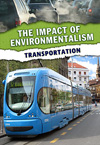 Not only does this book contain many familiar facts about global warming and the depletion of fossil fuel, but it also examines the effects the green movement is having on transportation. The author describes traffic jams and subsequent polluted air, and then discusses the environment became a hot topic. Interestingly, it wasn't the green movement that forced a reconsideration of humans’ dependence on cars and fossil fuels, but an oil crisis back in the 1970s. While providing examples of how different types of cars are being designed that can rely on alternative types of fuels, the author makes it clear that electric or hybrid cars aren't the sole answer either since cars that depend on batteries also need to be charged frequently. The inclusion of two cities that have tried to address transportation problems, Curitiba, Brazil, and Boston, Massachusetts, provide different approaches, one successful, and the other a failure. There are several questions to ponder as one reads this book since the solutions to the world's population and transportation problems are not as clear as might be expected.
Not only does this book contain many familiar facts about global warming and the depletion of fossil fuel, but it also examines the effects the green movement is having on transportation. The author describes traffic jams and subsequent polluted air, and then discusses the environment became a hot topic. Interestingly, it wasn't the green movement that forced a reconsideration of humans’ dependence on cars and fossil fuels, but an oil crisis back in the 1970s. While providing examples of how different types of cars are being designed that can rely on alternative types of fuels, the author makes it clear that electric or hybrid cars aren't the sole answer either since cars that depend on batteries also need to be charged frequently. The inclusion of two cities that have tried to address transportation problems, Curitiba, Brazil, and Boston, Massachusetts, provide different approaches, one successful, and the other a failure. There are several questions to ponder as one reads this book since the solutions to the world's population and transportation problems are not as clear as might be expected.
- Barbara A. Ward, Washington State University Pullman
Tanaka, Shelly. (2012). Nobody knows. Toronto, ON: Groundwood Books.
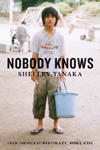 Written in a minimalist style that requires readers to read between the lines, this story describes how four siblings manage to survive after eventually being abandoned by their mother in an apartment in Tokyo. Readers realize there is something wrong as the two youngest children are smuggled into the apartment in suitcases so the landlord won't know about them. Appearance seems to be everything to this woman, who buys expensive presents for her four children, but then expects them to fend for themselves for long periods, leaving only a note and money when she takes off. The children aren't allowed to attend school, and they stick to her rules about being quiet and unseen for as long as they possibly can. But Akira is, after all, only twelve, and he finds the responsibility of taking care of his siblings and paying the bills challenging, especially when there is no more money in the bank account. In many respects, this book prods at readers’ social conscience, reminding them to pay attention to others similar to the Fukushimas, the ones that nobody seems to notice. While some passages in the book evoke pity and empathy and tear at the heart's strings, others prompt amazement at the resiliency of humans and the daily acts that spell survival for a family. Somehow, Akira finds a way to endure, relying on donations of day-old sushi, and even in the midst of the worst possible tragedy, his younger brother Shige finds reason for hope in the smallest piece of luck. This moving story will leave readers reconsidering their own actions, the thoughtlessness of others, and what lies ahead for these children.
Written in a minimalist style that requires readers to read between the lines, this story describes how four siblings manage to survive after eventually being abandoned by their mother in an apartment in Tokyo. Readers realize there is something wrong as the two youngest children are smuggled into the apartment in suitcases so the landlord won't know about them. Appearance seems to be everything to this woman, who buys expensive presents for her four children, but then expects them to fend for themselves for long periods, leaving only a note and money when she takes off. The children aren't allowed to attend school, and they stick to her rules about being quiet and unseen for as long as they possibly can. But Akira is, after all, only twelve, and he finds the responsibility of taking care of his siblings and paying the bills challenging, especially when there is no more money in the bank account. In many respects, this book prods at readers’ social conscience, reminding them to pay attention to others similar to the Fukushimas, the ones that nobody seems to notice. While some passages in the book evoke pity and empathy and tear at the heart's strings, others prompt amazement at the resiliency of humans and the daily acts that spell survival for a family. Somehow, Akira finds a way to endure, relying on donations of day-old sushi, and even in the midst of the worst possible tragedy, his younger brother Shige finds reason for hope in the smallest piece of luck. This moving story will leave readers reconsidering their own actions, the thoughtlessness of others, and what lies ahead for these children.
- Barbara A. Ward, Washington State University Pullman
These reviews are submitted by members of the International Reading Association's Children's Literature and Reading Special Interest Group (CL/R SIG) and are published weekly on Reading Today Online. The International Reading Association partners with the National Council of Teachers of English and Verizon Thinkfinity to produce ReadWriteThink.org, a website devoted to providing literacy instruction and interactive resources for grades K–12.